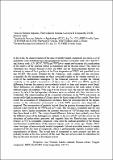Por favor, use este identificador para citar o enlazar a este item:
http://hdl.handle.net/10261/2607COMPARTIR / EXPORTAR:
 SHARE SHARE
 CORE
BASE CORE
BASE
|
|
| Visualizar otros formatos: MARC | Dublin Core | RDF | ORE | MODS | METS | DIDL | DATACITE | |

| Campo DC | Valor | Lengua/Idioma |
|---|---|---|
| dc.contributor.author | Iglesias, María José | - |
| dc.contributor.author | Río Andrade, José Carlos del | - |
| dc.contributor.author | Laggoun-Défarge, Fatima | - |
| dc.contributor.author | Cuesta, María José | - |
| dc.contributor.author | Suárez Ruiz, Isabel | - |
| dc.date.accessioned | 2007-12-26T14:59:01Z | - |
| dc.date.available | 2007-12-26T14:59:01Z | - |
| dc.date.issued | 2003 | - |
| dc.identifier.citation | Journal of Analytical and Applied Pyrolysis 68-69 (2003) 387-407 | en_US |
| dc.identifier.issn | 0165-2370 | - |
| dc.identifier.uri | http://hdl.handle.net/10261/2607 | - |
| dc.description.abstract | In this work, the characterization of the non-covalently bonded compounds present in a set of perhydrous coals of different age and geographical location (Cretaceous coals: UCV and TCV and Jurassic coals: AJV, PGJV, WJVh and WJVl) was carried out by means of a combination of the analyses of the material soluble in chloroform and the thermal extract. The extract in chloroform was studied through GC/MS and NMR and the thermovaporized fraction was obtained by means of flash pyrolysis at the Curie temperature of 350°C and quantified by on-line GC-MS. The results obtained for the Cretaceous coals confirm that the substances responsible for the hydrogenation are those covalently bonded to the vitrinite network as a result of the modifications undergone by the botanical precursors. Despite the striking similarity in the global characteristics of these two coals (TCV and UCV) significant differences between the material non-covalently bonded to their coal matrices were found. These differences are attributed to the type of resins present in the coals and/or to their different degree of evolution. With respect to the Jurassic coals, the present study allows the process by which the hydrogenated substances were assimilated into their structure to be established. The characterization of the assimilated substances in the WJVl coal reveals an unexpectedly high incorporation of alkanes given the humic origin of this sample. From these results the assimilation of hydrogen-rich substances from the decomposition of the organic remains in the sedimentary environment in which WJVl precursor were deposited, is proposed. The incorporation of products derived from the primary decomposition of organic material is not evident for the WJVh and AJV coals. The substances assimilated into the coal matrices show a higher aromaticity, the aromatic structures of WJVh being more condensed than those found in AJV. The compositional differences between them probably arise from the different source of the hydrogen-rich material. In the case of AJV coal the source was the adsorption of hydrocarbons generated and migrated from the Pliensbachian source-rocks whereas in WJVh, assimilated compounds come from the material generated by the thermal transformation (coalification) of the adjacent organic rocks of similar age. Finally, PGJV shows two types of non-covalently bonded compounds. Solvent extractable material is mainly composed of the first type of compounds, which is predominantly aliphatic in nature with a preponderance of alkanes. The second type of compounds is more aromatic and they are probably located in the close porosity of this coal. They are not accessible to chloroform but they are the most abundant in the thermal extract. | en_US |
| dc.description.sponsorship | The financial support for this work was provided through a contract with the European Community (No. 7220/EC-769). | en_US |
| dc.format.extent | 292130 bytes | - |
| dc.format.mimetype | application/pdf | - |
| dc.language.iso | eng | en_US |
| dc.publisher | Elsevier | en_US |
| dc.rights | openAccess | en_US |
| dc.subject | Perhydrous coal | en_US |
| dc.subject | Vitrinite | en_US |
| dc.subject | Soluble material | en_US |
| dc.subject | Thermal extract | en_US |
| dc.subject | Trapped compounds | en_US |
| dc.subject | NMR | en_US |
| dc.subject | Py–GC/MS (Curie temperature: 350°C) | en_US |
| dc.title | Chemical-structural characterization of solvent and thermal extractable material from perhydrous vitrinites | en_US |
| dc.type | artículo | en_US |
| dc.identifier.doi | 10.1016/S0165-2370(03)00068-8 | - |
| dc.description.peerreviewed | Peer reviewed | en_US |
| dc.contributor.funder | European Commission | - |
| dc.identifier.funder | http://dx.doi.org/10.13039/501100000780 | es_ES |
| dc.type.coar | http://purl.org/coar/resource_type/c_6501 | es_ES |
| item.languageiso639-1 | en | - |
| item.fulltext | With Fulltext | - |
| item.openairecristype | http://purl.org/coar/resource_type/c_18cf | - |
| item.cerifentitytype | Publications | - |
| item.grantfulltext | open | - |
| item.openairetype | artículo | - |
| Aparece en las colecciones: | (IRNAS) Artículos (INCAR) Artículos | |
Ficheros en este ítem:
| Fichero | Descripción | Tamaño | Formato | |
|---|---|---|---|---|
| Chemical_structural.pdf | 285,28 kB | Adobe PDF |  Visualizar/Abrir |
CORE Recommender
SCOPUSTM
Citations
11
checked on 31-mar-2024
WEB OF SCIENCETM
Citations
11
checked on 26-feb-2024
Page view(s)
399
checked on 23-abr-2024
Download(s)
272
checked on 23-abr-2024
Google ScholarTM
Check
Altmetric
Altmetric
NOTA: Los ítems de Digital.CSIC están protegidos por copyright, con todos los derechos reservados, a menos que se indique lo contrario.
